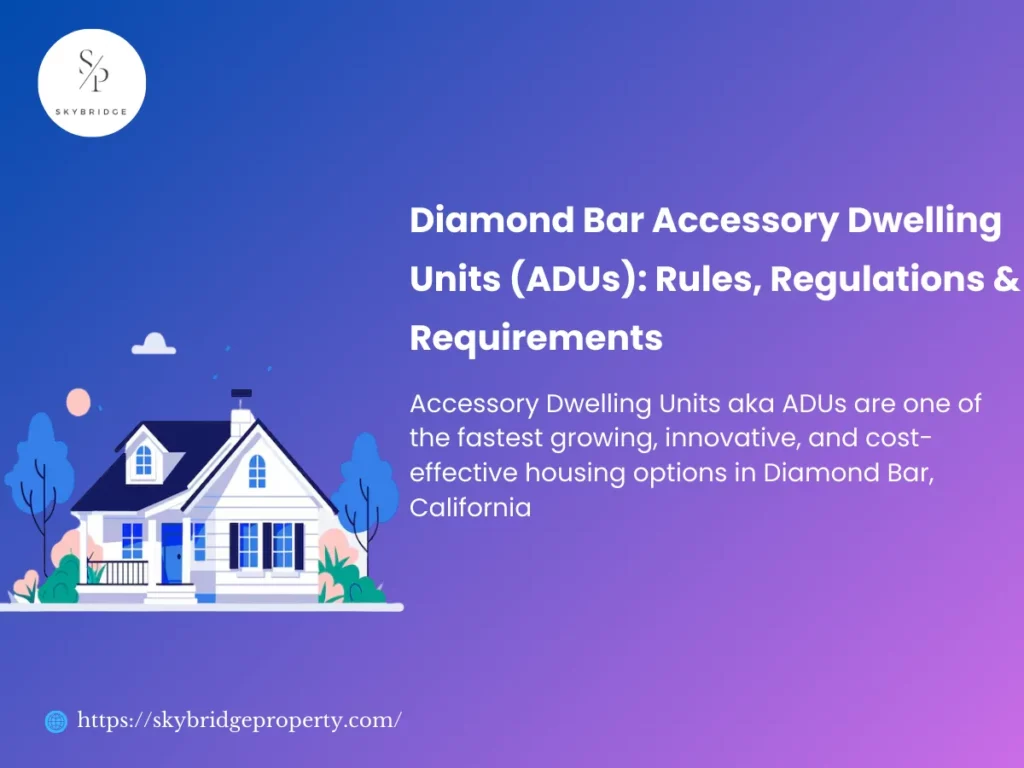Accessory Dwelling Units aka ADUs are one of the fastest growing, innovative, and cost-effective housing options in Diamond Bar, California. These are also known as secondary units, granny flats, in-law units, backyard cottages, or granny annexes. With the rising demand for reasonable housing, ADUs offers an affordable and functional living space opportunity for homeowners.
You can build an ADU or JADU on your property after getting a zoning and building permit from the local authorities. You should follow some basic procedure like getting a legit proof of property ownership, detailed ADU construction plan, and permit fee to get a permit.
What is an ADU?
An ADU or an accessory dwelling unit is a secondary housing unit (similar to an apartment unit) on a single-family residential lot. An ADU can be a unit within the primary house, or it can be attached to the main structure or a completely separate unit of its own. These units are also known as granny flats, in-law units, accessory apartments, granny annex, carriage home, secondary units, and backyard cottages.
It provides a complete, independent living facility for individuals, a small family, or in-laws for a multi-generational household purpose. Similarly, an ADU can be used as a short-term investment like AirBND or long-term rental property for homeowners. Moreover, these units can be used as affordable student housing options near campus.
Types of ADUs
There are several types of ADUs like detached ADU, attached ADU, conversion ADU, and Junior ADU (JADUs). Here is a list of four common structural forms of ADUs.
Detached ADUs
A detached ADU, also known as backyard cottages, granny flats, or laneway houses is a unit separate from the existing home. These detached ADUs are located in separate buildings with livable space with their own entrance, kitchen, bathroom, and living area. These units are ideal for rental purposes, guest house ideas, or independent living space for family members and also adds value to your property.
Attached ADUs
An attached ADU is a unit that is either contained within the walls of the primary house or is a newly constructed unit sharing a common wall with the main house. Although they are connected with the main house through a wall, they have a separate entrance. Attached ADUs provide a separate living space while still connected to the main house. This makes them an ultimate option for rental opportunities or multi-generational living.
Conversion ADUs
A conversion ADU is a process of converting a part of the house like a garage, attic, or basement into a separate living and functional space. These units are ideal for leveraging underutilized space for family use or renting increasing overall property’s value and utility. Conversion ADUs offer a practical and less intimidating approach to expanding living areas and are the most cost-effective ADU.
Junior ADUs (JADUs)
Junior ADU or JADU involves converting a part of the single-family home into a new unit. This space is not more than 500 square feet with an efficient kitchen, a separate entrance, and may share a bathroom with the primary house. JADU is considered as an affordable housing solution by California state laws, allowing easier permitting and flexible zoning requirements.
Benefits of ADUs
Building ADU in your property comes with multiple benefits to homeowners and buyers with an innovative solution to housing challenges. An ADU can provide housing for close family, adult children, or in-laws or even a rental space for tenants.
- Increased Property Value
A newly-built granny flats or secondary units adds instant resale value to your home with potential buyers seeing your ADU as an asset. An ADU can boost your home’s market value by adding livable space, a home office, a guest house, and rental income potential.
- Affordable Housing Option
Affordable housing is a pressing issue with the on-going housing crisis in several areas. ADUs can contribute to addressing this problem by providing affordable rental units in nice areas like Diamond Bar. You can rent these units to young adults, caregivers, or students at an affordable price.
- Rental Income
Having an ADU on your property comes with the potential for rental income. Homeowners can generate passive income by renting out the ADU to tenants, helping with mortgage payments, property taxes, or other expenses. Likewise, if you live in a high-demand rental area and host short-term vacation rental or AirBNB, you can get a premium price for your ADU.
- Zoning and Regulation Support
In a bold effort to combat the ongoing housing crises, California laws, including SB 9 and ADU-friendly policies, make it easier to build and permit ADUs. However, regulations for ADUs may vary depending on the location.
- Housing for Family Members
ADU assists multigenerational living arrangements allowing families to live together with independence and privacy. With an ADU unit, you can allow your immediate family, teenagers, or even in-laws to live with you comfortably, ultimately saving money. This allows families to maintain cultural and traditional values with stronger family bonds.
ADU Regulations for Diamond Bar Property
ADU has multiple rules and regulations for Diamond Bar Property. Learn specific information about these regulations down below:
Permitted Zones
You can build an ADU on your property as long as your property is in a location where an AUD is allowed and residential uses are allowed on it. Likewise, you should own an existing or proposed single-family home or a multi-family building on your property. Generally, ADU is allowed in all residentially zoned and mixed use districts, so you can also check if your location allows ADU online.
Number of ADUs allowed
Regardless of lot size, all residentially-zoned properties are eligible to build one ADU and one JADU. If you own a single-family home, you can build one to two ADUs, whereas, if you own a multi-family property, the number of ADUs allowed depends on how many units are already on the property and the type of ADU constructed.
Size (In Gross Floor Area)
While building an ADU, you should cover a minimum 220 square feet. For Detached ADUs, you can build a 1,000 sq.ft. for 2+ bedrooms unit max, 850 sq.ft. studio or 1 bedroom unit max, and 800 sq.ft. maximum if paired with a JADU.
Likewise, for Attached ADU, you can cover 1,000 sq.ft. or 50% of the existing living area of the primary residence. For JADUs, homeowners can cover 500 sq.ft at max, and 60 sq.ft for porches and patios.
Parking
Usually, conversion ADUs and JADUs don’t require parking space. Whereas, attached and detached ADUs will require 1 parking space, unless your property qualifies for an exemption
or it is located within a 1/2 mile of transit in walking distance.
Your property should be accessible from the existing driveway approach and may be provided with tandem parking on the existing driveway or in setback areas. Likewise, replacement parking is not required if a garage is converted into an ADU.
Development Standards
California state law requires a minimum 4-foot setback from the rear and side yard for Attached and Detached ADUs. Whereas, JADUs and conversion ADUs need to be set back a sufficient distance to ensure fire safety. Likewise, the maximum height limit for detached ADUs is 16 feet and a 6-foot separation is required between the ADU and the primary home or other structures.
There is no setback requirement for an existing permitted accessory structure that is converted into an ADU. Although lot coverage is based on zoning property, an 800 sq.ft. ADU is permitted on all residential lots.
Design
Usually, homeowners should be able to build an ADU that is at least one-story with 16 feet height. You can also build a two story ADU depending on your residential zoning code.
However, the exterior finish on an ADU should match the architectural style and design of the primary house. The materials, colors, roofing, and windows on ADU should be similar to the primary residence. The entrance to ADU and the primary home should be separate and should not face the same direction. Likewise, garages converted into an ADU should also match the architectural design of the house with the garage door replaced with exterior finishes.
Permitting Process
In 2020, LA implemented an improved permitting process to make life easier for homeowners planning to build an ADU. However, the amount of time to get an ADU permit in California varies significantly depending on the specific location and requirements.
Firstly, you need a zoning and planning permit from a local county in California. After that, you need a building permit which verifies that the ADU construction is safe and adheres to the current building codes. A building permit confirms if the ADU plans for the foundation, framing, electrical, and plumbing systems are up to code. Likewise, you also need an electrical and plumbing permit necessary for setting up electrical components and mandatory plumbing-related work.
Here is what you need to apply for a permit:
- A complete permit application form
- A legit proof of property ownership
- Plans of the existing space and proposed ADU project
- A detailed plans for ADU construction
- Payment for permit fees
After you follow the steps required, you need to wait for an approval or denial for the ADU project for up to a 60-day timeframe.
Conclusion
Understanding the importance of ADU rules and regulations is essential to make the process run efficiently and smoothly. Complying and aligning your plans with local regulations and Diamond Bar rental policies can encourage safety and proper communication for the construction crew as well as the homeowners. You will be able to create accessible housing opportunities for tenants, family, and friends while enhancing your property value when you comply with the rules and regulations. And if you’re a homeowner in Diamond Bar looking to build an ADU to increase rental income, our Diamond Bar Property Management Experts team can help you with the compliance, maintenance, tenant placement, and rent collection. We offer a comprehensive range of property management services around Los Angeles with an understanding of local real estate market trends, regulations, transparent pricing, and legal expertise.
FAQs
Can I sell an ADU separately from my primary residence in Diamond Bar?
No, ADUs cannot be sold separately from the primary residence in Diamond Bar as they must remain part of the same property.
Are short-term rentals allowed for ADUs in Diamond Bar?
Short-term rentals are prohibited in all residential zones within Diamond Bar. The rental time-span should be longer than 30 days.
Do I need to live in the primary residence or the ADU if I build one in Diamond Bar?
The homeowners are not required to live in the primary residence or the ADU itself if your ADU permit was approved on or after January 1st, 2025.
Does an ADU in Diamond Bar increase rental income?
Yes, building an ADU in Diamond Bar increases steady rental income as well as increases your property value. As ADUs are independent living units, homeowners can lease them to long-term tenants.







